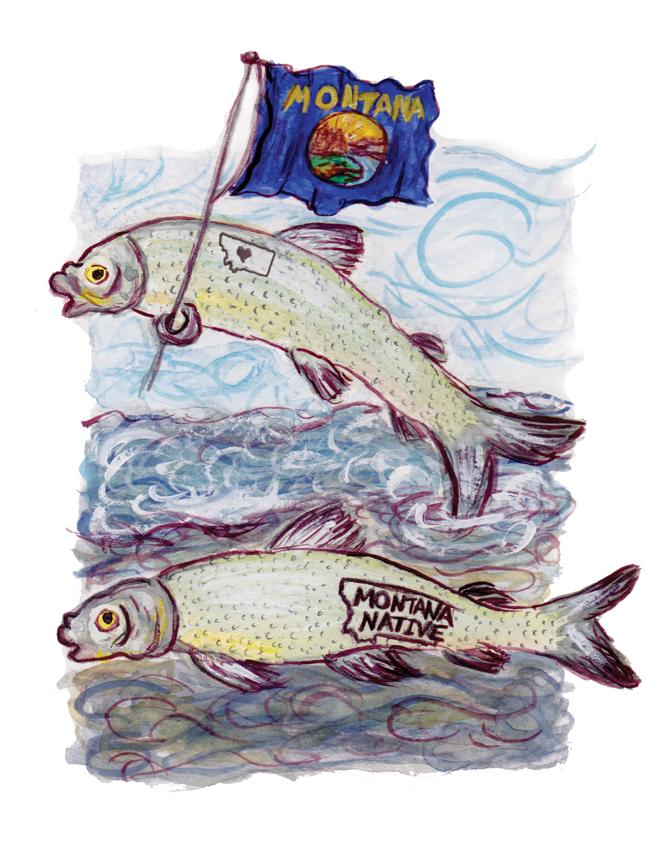Native Rights
One of my earliest fishing memories has a mountain whitefish at its heart. I don’t know how old I was, but I do know that I was infected by the fishing fever. I loved to catch fish, and when your age is measured in single digits, you don’t care what the fish looks like—even if mountain whitefish kind of look like the basset hound of the salmonids. It was just plain fun.
It would be nice if the attitude of a nine-year-old were carried over to adult life, at least for some of us. If you were raised on a Western river, weaned under that big Western sky, you’ve had a long relationship with the mountain whitefish. They were the fish that saved the trout-free day when the going got tough. If you were fishing the Madison, the Yellowstone, or the Big Hole and having no luck with those finicky browns, cutthroats, or rainbows, you could switch to a nymph and start sacking up the mountain whitefish. The same was true in other western states like Wyoming and Colorado, and like other state game agencies, the bag limits were liberal. Forty fish a day, or Montana’s famous ten-pounds-plus-one-fish of the old days. The tug on the line was the same, and smoked over alder coals, whitefish were delicious.
Somewhere in there, we fishermen floated down the wrong channel with our attitude toward this important native fish. Some blame the guides, some blame the clients. In the 1980s and 1990s, attitudes toward whitefish changed significantly, becoming elitist. Instead of a meat supply, a fun fish to catch, and an honored member of our ecosystem, whitefish became victim of a smear campaign that would make the worst political TV ads seem kindly. Guides urged clients to toss whitefish up on the bank or squeeze them hard before throwing them—not softly—back into the river. This misguided, highly unethical and illegal practice does nothing but reveal a basic ignorance in how the web of native fisheries ties all together in the West. Simultaneously, while this knuckle-dragger attitude was in full throat, the populations of whitefish abruptly tanked on some major rivers. Today, anglers on well-known whitefish rivers such as Colorado’s Yampa and Montana’s Madison would have trouble catching any whitefish, let alone a limit.
“All of a sudden, people went from catching two trout a day and 40 whitefish to catching two trout a day and no whitefish, and everyone was asking us ‘Where did all the whitefish go?’” says Kevin Rogers, an aquatic research biologist in Steamboat Springs, Colorado.
“This is a fish we’ve taken for granted for a long time and in some places they look like they’re under duress and we don’t know why,” says Dave Kumlien, executive director of Trout Unlimited’s Whirling Disease Foundation and a long-time Montanan.
Kumlien, who was once a guide, remembers an era when a fisherman could float from Varney Bridge on the Madison to Ennis and “fill your boat with [mountain whitefish]. Now you can make that same float and you won’t catch very many.”
All across the West, from the Blackfoot to the Yampa, that appears to be the case. Sadly, however, very little is know about how mountain whitefish live, eat, and swim in our western rivers. What is known is cutting-edge.
“It’s pioneering work because not a lot has been done on the whitefish to begin with, and that makes it kind of fun,” says Rogers.
The reason the whitefish hasn’t been studied much has a lot to do with its former abundance—traditional fish survey methods that work on trout just don’t work on whitefish. What’s more, because they were abundant and not as highly sought as trout, fisheries’ management agencies put their precious resources into more popular game fish like trout. Why mess around with whitefish when there are so many of them, and people would more appreciate a trout on the other end of their line?
Then, whitefish populations went in the toilet. “Society seems to be taking a different look at whitefish now,” says Travis Horton, a biologist with Montana Fish, Wildlife and Parks in Bozeman. “When things get more rare, they get more attention from people. As fishermen, you could always go salvage a bad day by switching to a nymph and catch whitefish. Now, you can’t do that any more. Plus, there seems to be more appreciation of native fish and the mountain whitefish is a native fish. It belongs here.”
In Colorado, state fisheries biologists like Rogers were able to surmise that the decline of the Yampa’s whitefish might have a lot to do with rising water temperatures spurred on by drought, along with whirling disease and predatory warm-water species in the lower end of the drainage.
But on our Madison, the picture isn’t as clear. While advocates of the whitefish may disagree on the root causes, what everyone agrees on is that whitefish are the “canary in the coalmine” for the health of a watershed. Some differ on concerns such as whirling disease’s impact on whitefish, but everyone agrees that drought, warming water temperatures, and metal toxicity can all cause the whitefish population to sharply decline. And as go whitefish, so go trout say some.
“We are supposed to be taking care of all the salmonids, and if whitefish aren’t doing well in a river, we want to know why,” says Kumlien.
The Madison River Foundation felt exactly the same way when they helped secure funding to study whitefish on the Madison River. That study has a MSU graduate student following 70 tagged whitefish up and down the Madison River from Quake Lake to Ennis Lake in an effort to understand how the fish moves through the system. It is hoped that learning more about whitefish will result in learning why the Madison River’s whitefish population appears to be in deep trouble.
In collaboration between the foundation, Montana Fish, Wildlife and Parks, MSU and the U.S. Fish and Wildlife Service’s Bozeman Fish Technology Center, small transmitters about half the size of a pinky finger are surgically implanted into adult, sexually mature whitefish. Using a radio receiver, the graduate student then floats the Madison almost every day from September through November—whitefish spawn in large schools in the fall—as she learns more about how the fish swims in the Madison. Under the guidance of Chris Guy, professor of fisheries science at MSU, the study attempts to answer as many questions about Madison River whitefish as possible.
“Where are these fish going? What are they doing? What is their reproductive life cycle? Where are they spawning? Is it habitat limiting?” asks Guy. “So little is known about mountain whitefish, that this will hopefully lead to a better understanding of the ecology and how they fit into the whole ecosystem.”
Although still very early in the study, results seem to indicate that whitefish tagged far up the river will move downstream as far as—or into—Ennis Lake for the winter, says Guy.
What is clear is that mountain whitefish are a native fish that provide an important element in the food chain, whether it is as a sport fish for anglers, a forage fish for big marauding trout, or food for hungry osprey and eagles (radio transmitters from unfortunate whitefish have been found below the nests of these two fish-eating birds).
“It’s a native species, it’s not as pretty as a trout, but it’s a great fish,” says Kumlien. “I’m glad we’ve got them in our rivers.”
Tom Reed lives outside Pony, Montana, and is the author of four books. For more information, visit tomreedbooks.com.
Illustration by Angie Mangels












